The Repetitive Transcranial Magnetic Stimulation Market is estimated to be valued at USD 1.5 billion in 2025 and is projected to reach USD 3.6 billion by 2035, registering a compound annual growth rate (CAGR) of 9.2% over the forecast period.
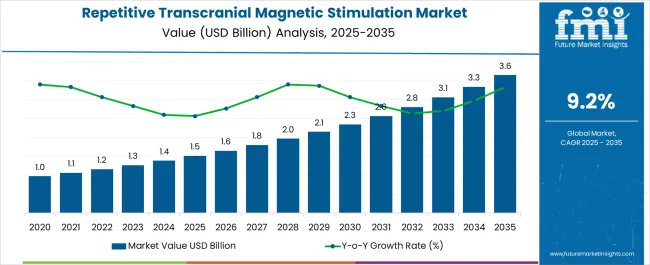
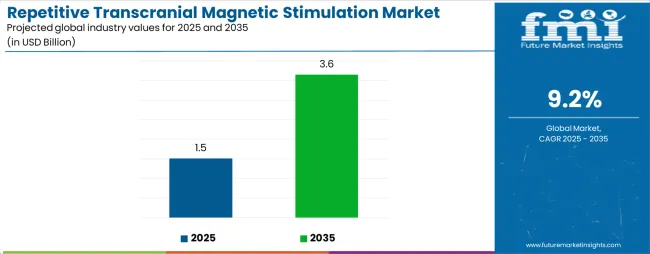
| Metric | Value |
|---|---|
| Repetitive Transcranial Magnetic Stimulation Market Estimated Value in (2025 E) | USD 1.5 billion |
| Repetitive Transcranial Magnetic Stimulation Market Forecast Value in (2035 F) | USD 3.6 billion |
| Forecast CAGR (2025 to 2035) | 9.2% |
The Repetitive Transcranial Magnetic Stimulation market is experiencing steady expansion, supported by its growing clinical relevance in the treatment of neurological and psychiatric disorders. The current landscape reflects strong adoption in mental health management, particularly for depression and anxiety, alongside increasing research for broader therapeutic applications such as post stroke recovery, Alzheimer’s disease, and chronic pain management.
The market outlook is being shaped by rising mental health awareness, greater investment in neuroscience research, and improved reimbursement structures in several regions. Clinical trials and ongoing advancements in device engineering are enhancing patient safety, treatment precision, and overall therapy outcomes, which is expected to strengthen adoption across medical practices.
Furthermore, non invasive neuromodulation therapies such as rTMS are gaining preference due to reduced side effects compared to pharmacological approaches As healthcare systems continue to emphasize personalized medicine and evidence based therapeutic interventions, rTMS is positioned to play a more prominent role in the treatment spectrum, paving the way for consistent long term market growth.
The repetitive transcranial magnetic stimulation market is segmented by product type, end use, and geographic regions. By product type, repetitive transcranial magnetic stimulation market is divided into Low Frequency and High Frequency. In terms of end use, repetitive transcranial magnetic stimulation market is classified into Hospital and Specialized Clinic. Regionally, the repetitive transcranial magnetic stimulation industry is classified into North America, Latin America, Western Europe, Eastern Europe, Balkan & Baltic Countries, Russia & Belarus, Central Asia, East Asia, South Asia & Pacific, and the Middle East & Africa.
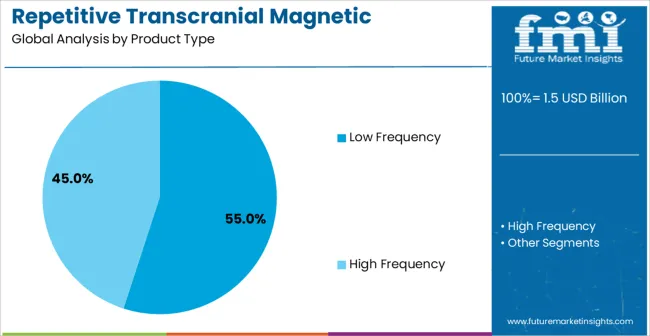
The Low Frequency product type segment is projected to account for 55.00% of the Repetitive Transcranial Magnetic Stimulation market revenue in 2025, making it the leading segment in terms of product preference. This dominance is being driven by its proven clinical effectiveness in managing treatment resistant depression and its established safety profile. Low frequency stimulation is widely recognized for reducing cortical excitability, which makes it suitable for patients with psychiatric and neurological conditions where regulation of hyperactive brain regions is essential.
The adoption of this product type has been reinforced by clinical guidelines and the growing body of evidence demonstrating its sustained therapeutic outcomes. Ease of administration and relatively shorter training requirements for practitioners have further supported its growth trajectory.
Hospitals and clinics are increasingly favoring low frequency devices because of their scalability, predictable response rates, and cost effectiveness compared to alternative modalities The rising prevalence of mental health disorders and the increasing inclination toward non invasive treatments have further established the segment’s leading position in the market.
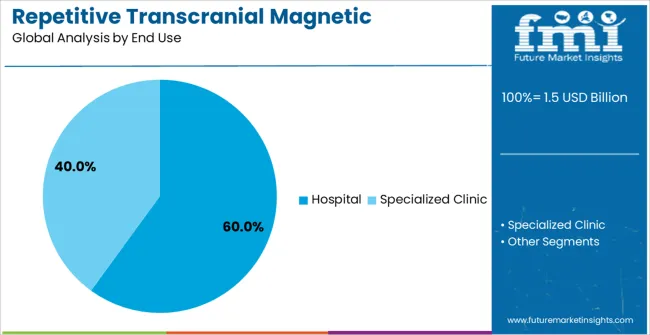
The Hospital end use segment is expected to command 60.00% of the overall Repetitive Transcranial Magnetic Stimulation market revenue in 2025, representing the most significant share among end user categories. This dominance is being attributed to the widespread availability of advanced medical infrastructure, trained professionals, and the ability to manage high patient volumes. Hospitals are the primary centers for the administration of rTMS therapy, given their access to specialized neuropsychiatric departments and integration of multidisciplinary care.
The segment’s growth has also been fueled by favorable reimbursement in hospital settings, as well as the rising number of mental health cases being diagnosed and treated in institutional environments. Hospitals are positioned as the most trusted facilities for adopting innovative treatment modalities due to their regulatory compliance and focus on patient safety.
Furthermore, as clinical research trials for expanding rTMS applications are often conducted in hospital environments, early adoption of new techniques and devices becomes more feasible These combined factors are expected to ensure the hospital segment continues to lead the market over the forecast period.
Repetitive transcranial magnetic stimulation is a non-invasive procedure which accounts for brain health procedure. Procedure involves magnetic stimulation to stimulate nerve cells present in brain to improve symptoms of irregular pulses.
The device comprise of an electromagnetic coil which delivers continuous magnetic pulses to stimulate nerve cells. Repetitive transcranial magnetic stimulation is primarily meant as a non-invasive procedure for treating depression.
Unlike other contemporary solutions like deep brain stimulation and vagus nerve stimulation which are invasive in nature, repetitive transcranial magnetic stimulation comes out to be the most certain of the lot. A session of repetitive transcranial magnetic stimulation typically takes around 30 minutes and is given on consecutive times for optimum results.
The procedure does not require any anaesthetic or sedation and comes as a procedure with minimal effects on brain memory. Standard treatment for depression includes prescribed drugs which are not suitable for most of the cases, but repetitive transcranial magnetic stimulation is suitable in most cases and recommended for patients responding negative to depression drugs.
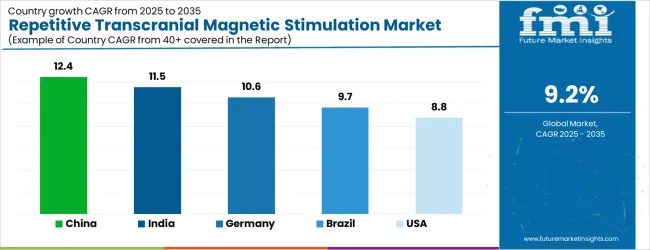
| Country | CAGR |
|---|---|
| China | 12.4% |
| India | 11.5% |
| Germany | 10.6% |
| Brazil | 9.7% |
| USA | 8.8% |
| UK | 7.8% |
| Japan | 6.9% |
The Repetitive Transcranial Magnetic Stimulation Market is expected to register a CAGR of 9.2% during the forecast period, exhibiting varied country level momentum. China leads with the highest CAGR of 12.4%, followed by India at 11.5%. Developed markets such as Germany, France, and the UK continue to expand steadily, while the USA is likely to grow at consistent rates. Japan posts the lowest CAGR at 6.9%, yet still underscores a broadly positive trajectory for the global Repetitive Transcranial Magnetic Stimulation Market. In 2024, Germany held a dominant revenue in the Western Europe market and is expected to grow with a CAGR of 10.6%. The USA Repetitive Transcranial Magnetic Stimulation Market is estimated to be valued at USD 567.8 million in 2025 and is anticipated to reach a valuation of USD 567.8 million by 2035. Sales are projected to rise at a CAGR of 0.0% over the forecast period between 2025 and 2035. While Japan and South Korea markets are estimated to be valued at USD 82.2 million and USD 40.5 million respectively in 2025.
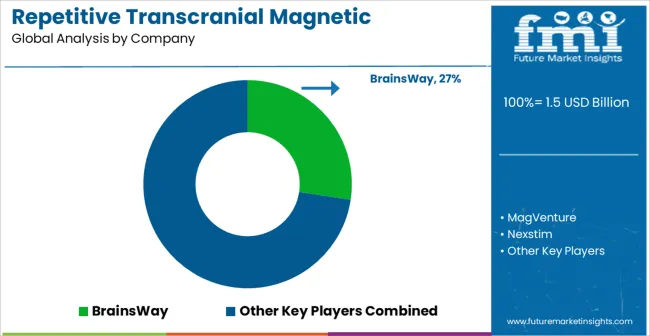
| Item | Value |
|---|---|
| Quantitative Units | USD 1.5 Billion |
| Product Type | Low Frequency and High Frequency |
| End Use | Hospital and Specialized Clinic |
| Regions Covered | North America, Europe, Asia-Pacific, Latin America, Middle East & Africa |
| Country Covered | United States, Canada, Germany, France, United Kingdom, China, Japan, India, Brazil, South Africa |
| Key Companies Profiled | BrainsWay, MagVenture, Nexstim, Neuronetics, Magstim, eNeura, Soterix Medical, and Neurosoft |
The global repetitive transcranial magnetic stimulation market is estimated to be valued at USD 1.5 billion in 2025.
The market size for the repetitive transcranial magnetic stimulation market is projected to reach USD 3.6 billion by 2035.
The repetitive transcranial magnetic stimulation market is expected to grow at a 9.2% CAGR between 2025 and 2035.
The key product types in repetitive transcranial magnetic stimulation market are low frequency and high frequency.
In terms of end use, hospital segment to command 60.0% share in the repetitive transcranial magnetic stimulation market in 2025.






Our Research Products

The "Full Research Suite" delivers actionable market intel, deep dives on markets or technologies, so clients act faster, cut risk, and unlock growth.

The Leaderboard benchmarks and ranks top vendors, classifying them as Established Leaders, Leading Challengers, or Disruptors & Challengers.

Locates where complements amplify value and substitutes erode it, forecasting net impact by horizon

We deliver granular, decision-grade intel: market sizing, 5-year forecasts, pricing, adoption, usage, revenue, and operational KPIs—plus competitor tracking, regulation, and value chains—across 60 countries broadly.

Spot the shifts before they hit your P&L. We track inflection points, adoption curves, pricing moves, and ecosystem plays to show where demand is heading, why it is changing, and what to do next across high-growth markets and disruptive tech

Real-time reads of user behavior. We track shifting priorities, perceptions of today’s and next-gen services, and provider experience, then pace how fast tech moves from trial to adoption, blending buyer, consumer, and channel inputs with social signals (#WhySwitch, #UX).

Partner with our analyst team to build a custom report designed around your business priorities. From analysing market trends to assessing competitors or crafting bespoke datasets, we tailor insights to your needs.
Supplier Intelligence
Discovery & Profiling
Capacity & Footprint
Performance & Risk
Compliance & Governance
Commercial Readiness
Who Supplies Whom
Scorecards & Shortlists
Playbooks & Docs
Category Intelligence
Definition & Scope
Demand & Use Cases
Cost Drivers
Market Structure
Supply Chain Map
Trade & Policy
Operating Norms
Deliverables
Buyer Intelligence
Account Basics
Spend & Scope
Procurement Model
Vendor Requirements
Terms & Policies
Entry Strategy
Pain Points & Triggers
Outputs
Pricing Analysis
Benchmarks
Trends
Should-Cost
Indexation
Landed Cost
Commercial Terms
Deliverables
Brand Analysis
Positioning & Value Prop
Share & Presence
Customer Evidence
Go-to-Market
Digital & Reputation
Compliance & Trust
KPIs & Gaps
Outputs
Full Research Suite comprises of:
Market outlook & trends analysis
Interviews & case studies
Strategic recommendations
Vendor profiles & capabilities analysis
5-year forecasts
8 regions and 60+ country-level data splits
Market segment data splits
12 months of continuous data updates
DELIVERED AS:
PDF EXCEL ONLINE
Magnetic Absorption Data Line Market Size and Share Forecast Outlook 2025 to 2035
Magnetic Material Magnetization and Testing Equipment Market Size and Share Forecast Outlook 2025 to 2035
Magnetic Coupler Market Size and Share Forecast Outlook 2025 to 2035
Magnetic Shielding Device Market Size and Share Forecast Outlook 2025 to 2035
Magnetic Stripe Readers Market Size and Share Forecast Outlook 2025 to 2035
Magnetic Resonance Analyzer Market Size and Share Forecast Outlook 2025 to 2035
Magnetic Drive Pump Market Size and Share Forecast Outlook 2025 to 2035
Magnetic Separator Market Size and Share Forecast Outlook 2025 to 2035
Magnetic Ballast Market Size and Share Forecast Outlook 2025 to 2035
Magnetic Sensor Market Size and Share Forecast Outlook 2025 to 2035
Magnetic Flowmeter Market Size and Share Forecast Outlook 2025 to 2035
Magnetic Resonance Imaging Coils Market Analysis - Size, Share, and Forecast 2025 to 2035
Magnetic Tape Market Analysis Size and Share Forecast Outlook 2025 to 2035
Magnetic Resonance Imaging (MRI) Contrast Agents Market Size and Share Forecast Outlook 2025 to 2035
Magnetic Crack Detectors Market Size and Share Forecast Outlook 2025 to 2035
Transcranial Doppler Ultrasounds System Market Size and Share Forecast Outlook 2025 to 2035
Magnetic Materials Market Growth - Trends & Forecast 2025 to 2035
Magnetic Resonance Imaging (MRI) Market Trends - Size, Share & Forecast 2025 to 2035
Magnetic Grill Market Analysis – Trends, Growth & Forecast 2025 to 2035
Magnetic Closure Boxes Market Trends - Growth & Demand 2025 to 2035

Thank you!
You will receive an email from our Business Development Manager. Please be sure to check your SPAM/JUNK folder too.
Chat With
MaRIA